RENAULT KANGOO ZERO EMISSION 2012 X61 / 2.G User Guide
Manufacturer: RENAULT, Model Year: 2012, Model line: KANGOO ZERO EMISSION, Model: RENAULT KANGOO ZERO EMISSION 2012 X61 / 2.GPages: 213, PDF Size: 6.08 MB
Page 11 of 213
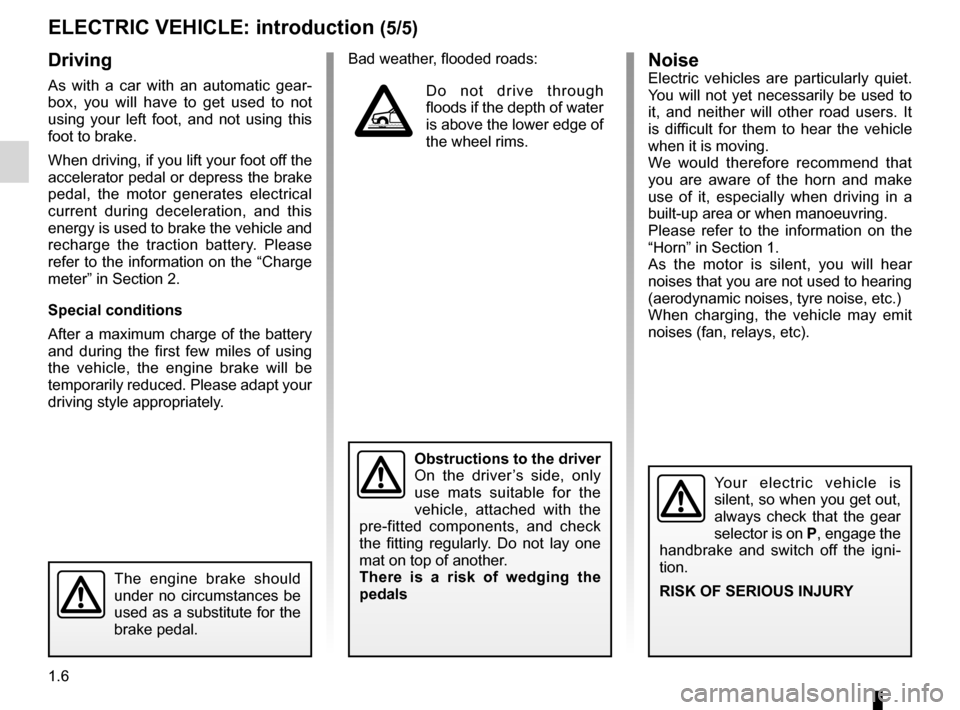
electric vehiclenoise ................................................................ (current page)
electric vehicle driving .............................................................. (current page)
1.6
ENG_UD28551_3
Véhicule électrique : présentation (X61 électrique - Renaul\
t)
ENG_NU_911-4_F61e_Renault_1
The engine brake should
under no circumstances be
used as a substitute for the
brake pedal.
NoiseElectric vehicles are particularly quiet.
You will not yet necessarily be used to
it, and neither will other road users. It
is difficult for them to hear the vehicle
when it is moving.
We would therefore recommend that
you are aware of the horn and make
use of it, especially when driving in a
built-up area or when manoeuvring.
Please refer to the information on the
“Horn” in Section 1.
As the motor is silent, you will hear
noises that you are not used to hearing
(aerodynamic noises, tyre noise, etc.)
When charging, the vehicle may emit
noises (fan, relays, etc).
Your electric vehicle is
silent, so when you get out,
always check that the gear
selector is on P, engage the
handbrake and switch off the igni -
tion.
riSK OF SeriOUS iNJUr Y
electric vehicle: introduction (5/5)
Driving
As with a car with an automatic gear -
box, you will have to get used to not
using your left foot, and not using this
foot to brake.
When driving, if you lift your foot off the
accelerator pedal or depress the brake
pedal, the motor generates electrical
current during deceleration, and this
energy is used to brake the vehicle and
recharge the traction battery. Please
refer to the information on the “Charge
meter” in Section 2.
Special conditions
After a maximum charge of the battery
and during the first few miles of using
the vehicle, the engine brake will be
temporarily reduced. Please adapt your
driving style appropriately. Bad weather, flooded roads:Do not drive through
floods if the depth of water
is above the lower edge of
the wheel rims.
Obstructions to the driver
On the driver ’s side, only
use mats suitable for the
vehicle, attached with the
pre-fitted components, and check
the fitting regularly. Do not lay one
mat on top of another.
t here is a risk of wedging the
pedals
Page 12 of 213
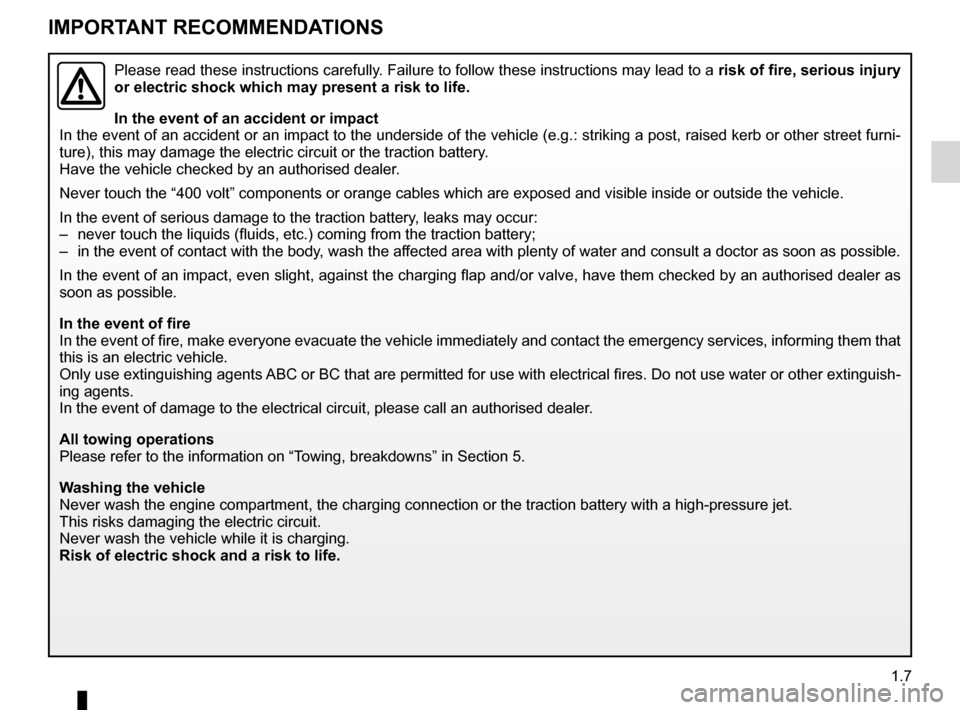
»400 volt» electrical circuit .................................... (current page)
charging flap .......................................................... (current page)
electric vehicle important recommendations ............................ (current page)
traction battery ....................................................... (current page)
1.7
ENG_UD28908_4
Recommandations importantes (X38 - X61 électrique - L38 électriqu\
e - Renault)
ENG_NU_911-4_F61e_Renault_1
Important recommendations
imPOrt ANt recOmmeNDA tiONS
Please read these instructions carefully. Failure to follow these instructions may lead to a risk of fire, serious injury
or electric shock which may present a risk to life.
in the event of an accident or impact
In the event of an accident or an impact to the underside of the vehicle (e.g.: striking a post, raised kerb or other street furni-
ture), this may damage the electric circuit or the traction battery.
Have the vehicle checked by an authorised dealer.
Never touch the “400 volt” components or orange cables which are e\
xposed and visible inside or outside the vehicle.
In the event of serious damage to the traction battery, leaks may occur:
– never touch the liquids (fluids, etc.) coming from the traction battery;
– in the event of contact with the body, wash the affected area with plenty of water and consult a doctor as soon as possibl\
e.
In the event of an impact, even slight, against the charging flap and/or valve, have them checked by an authorised dealer as
soon as possible.
in the event of fire
In the event of fire, make everyone evacuate the vehicle immediately and contact the emergency services, informing them that
this is an electric vehicle.
Only use extinguishing agents ABC or BC that are permitted for use with electrical fires. Do not use water or other extinguish -
ing agents.
In the event of damage to the electrical circuit, please call an authori\
sed dealer.
All towing operations
Please refer to the information on “Towing, breakdowns” in Section 5.
Washing the vehicle
Never wash the engine compartment, the charging connection or the tracti\
on battery with a high-pressure jet.
This risks damaging the electric circuit.
Never wash the vehicle while it is charging.
risk of electric shock and a risk to life.
Page 13 of 213
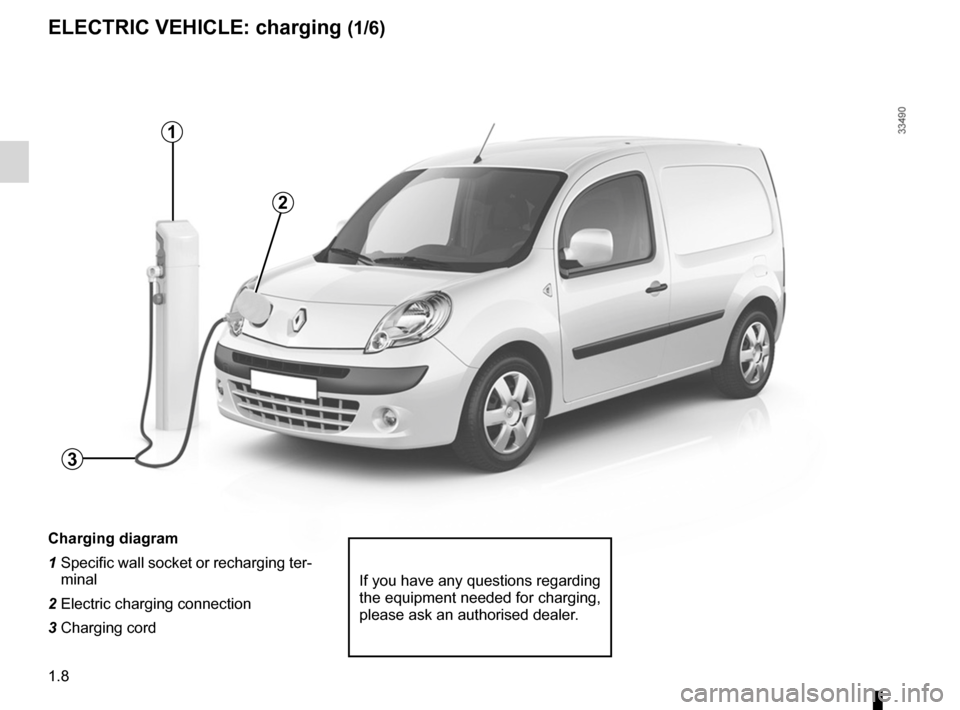
traction battery charge .......................... (up to the end of the DU)
charging cord ........................................ (up to the end of the DU)
charging socket .................................... (up to the end of the DU)
charging flap ......................................... (up to the end of the DU)
electric vehicle charge ............................................. (up to the end of the DU)
energy charge ............................................. (up to the end of the DU)
traction battery charge .............................................................. (current page)
1.8
ENG_UD28552_4
Véhicule électrique : charge (X61 - X61 électrique - Renault)\
ENG_NU_911-4_F61e_Renault_1
Jaune NoirNoir texte
Electric vehicle: charging
electric vehicle: charging (1/6)
charging diagram
1 Specific wall socket or recharging ter-
minal
2 Electric charging connection
3 Charging cord
If you have any questions regarding
the equipment needed for charging,
please ask an authorised dealer.
1
2
3
Page 14 of 213
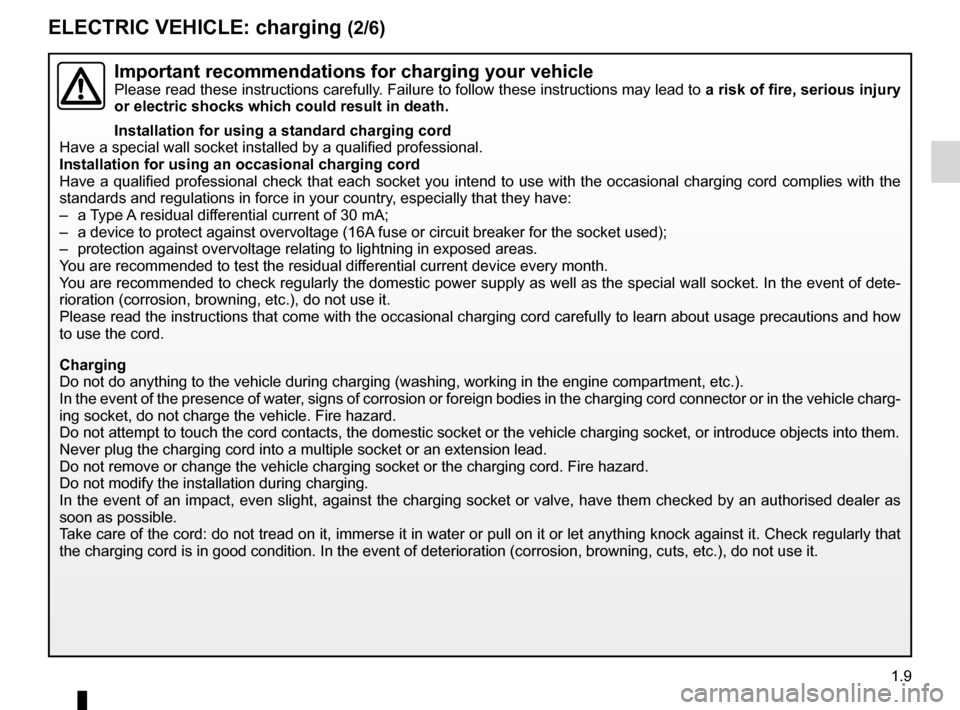
electric vehicleimportant recommendations ............................ (current page)
electrical installation .............................................. (current page)
JauneNoirNoir texte
1.9
ENG_UD28552_4
Véhicule électrique : charge (X61 - X61 électrique - Renault)\
ENG_NU_911-4_F61e_Renault_1
electric vehicle: charging (2/6)
important recommendations for charging your vehiclePlease read these instructions carefully. Failure to follow these instructions may lead to a risk of fire, serious injury
or electric shocks which could result in death.
installation for using a standard charging cord
Have a special wall socket installed by a qualified professional.
installation for using an occasional charging cord
Have a qualified professional check that each socket you intend to use with the occasional charging cord complies with the
standards and regulations in force in your country, especially that they have:
– a Type A residual differential current of 30 mA;
– a device to protect against overvoltage (16A fuse or circuit breaker for the socket used);
– protection against overvoltage relating to lightning in exposed areas.
You are recommended to test the residual differential current device every month.
You are recommended to check regularly the domestic power supply as well as the special wall socket. In the event of dete-
rioration (corrosion, browning, etc.), do not use it.
Please read the instructions that come with the occasional charging cord carefully to learn about usage precautions and how
to use the cord.
charging
Do not do anything to the vehicle during charging (washing, working in \
the engine compartment, etc.).
In the event of the presence of water, signs of corrosion or foreign bodies in the charging cord connector or in the vehicle charg-
ing socket, do not charge the vehicle. Fire hazard.
Do not attempt to touch the cord contacts, the domestic socket or the ve\
hicle charging socket, or introduce objects into them.
Never plug the charging cord into a multiple socket or an extension lead\
.
Do not remove or change the vehicle charging socket or the charging cord\
. Fire hazard.
Do not modify the installation during charging.
In the event of an impact, even slight, against the charging socket or valve, have them checked by an authorised dealer as
soon as possible.
Take care of the cord: do not tread on it, immerse it in water or pull on it or let anything knock against it. Check regularly that
the charging cord is in good condition. In the event of deterioration (\
corrosion, browning, cuts, etc.), do not use it.
Page 15 of 213
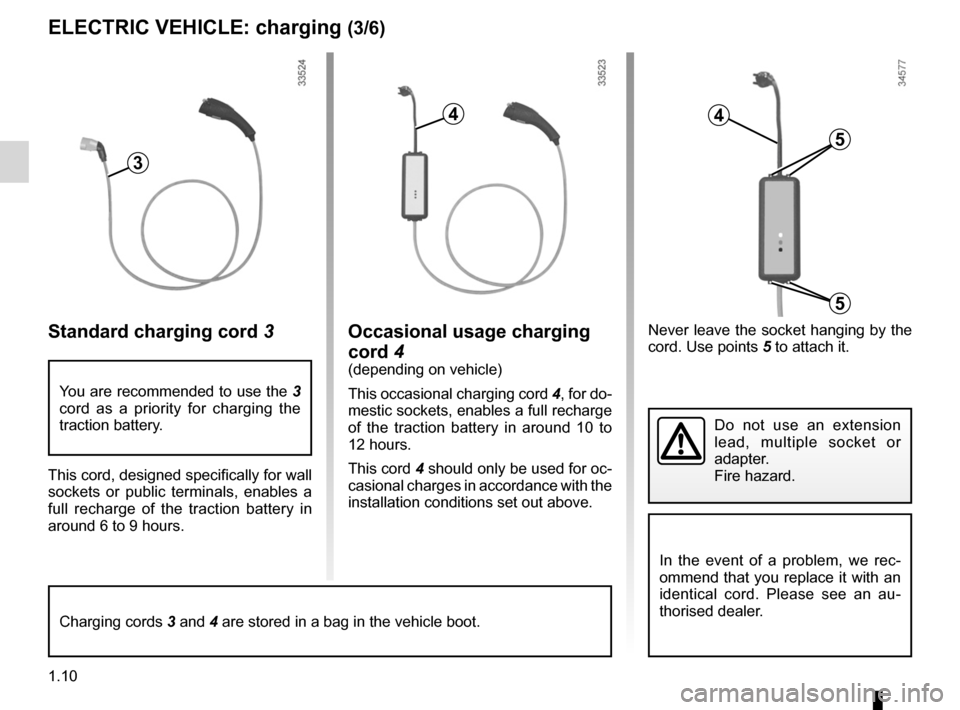
1.10
ENG_UD28552_4
Véhicule électrique : charge (X61 - X61 électrique - Renault)\
ENG_NU_911-4_F61e_Renault_1
Jaune NoirNoir texte
Standard charging cord 3
This cord, designed specifically for wall
sockets or public terminals, enables a
full recharge of the traction battery in
around 6 to 9 hours.
electric vehicle: charging (3/6)
4
5
5
You are recommended to use the 3
cord as a priority for charging the
traction battery.
3
4
Never leave the socket hanging by the
cord. Use points 5 to attach it.Occasional usage charging
cord 4
(depending on vehicle)
This occasional charging cord 4, for do-
mestic sockets, enables a full recharge
of the traction battery in around 10 to
12 hours.
This cord 4 should only be used for oc-
casional charges in accordance with the
installation conditions set out above.
Do not use an extension
lead, multiple socket or
adapter.
Fire hazard.
Charging cords 3 and 4 are stored in a bag in the vehicle boot.
In the event of a problem, we rec -
ommend that you replace it with an
identical cord. Please see an au -
thorised dealer.
Page 16 of 213

JauneNoirNoir texte
1.11
ENG_UD28552_4
Véhicule électrique : charge (X61 - X61 électrique - Renault)\
ENG_NU_911-4_F61e_Renault_1
electric vehicle: charging (4/6)
charging connection 2
The vehicle has a charging connection
located at the front of the vehicle. Avoid charging and parking your ve
-
hicle in extreme temperatures (hot or
cold).
When the vehicle is parked in tempera-
tures lower than around -25°C, the bat-
tery cannot be charged.
Favour charging the traction battery
after driving and/or in mild tempera -
tures. Otherwise, charging may take a
longer period of time or even become
impossible.
2
In the absence of any protection
against overvoltage, you are recom-
mended not to charge the vehicle in
stormy weather (lightning, etc.).
recommendations
– In extreme heat, favour parking and
recharging the vehicle in a shaded/
covered location.
– Charging can be performed in the
rain or snow.
Note:
If in a snowy environment, remove
snow from the vehicle charging area
before plugging in or disconnecting.
Snow in the socket may block the in -
sertion of the charging cord plug.
Page 17 of 213
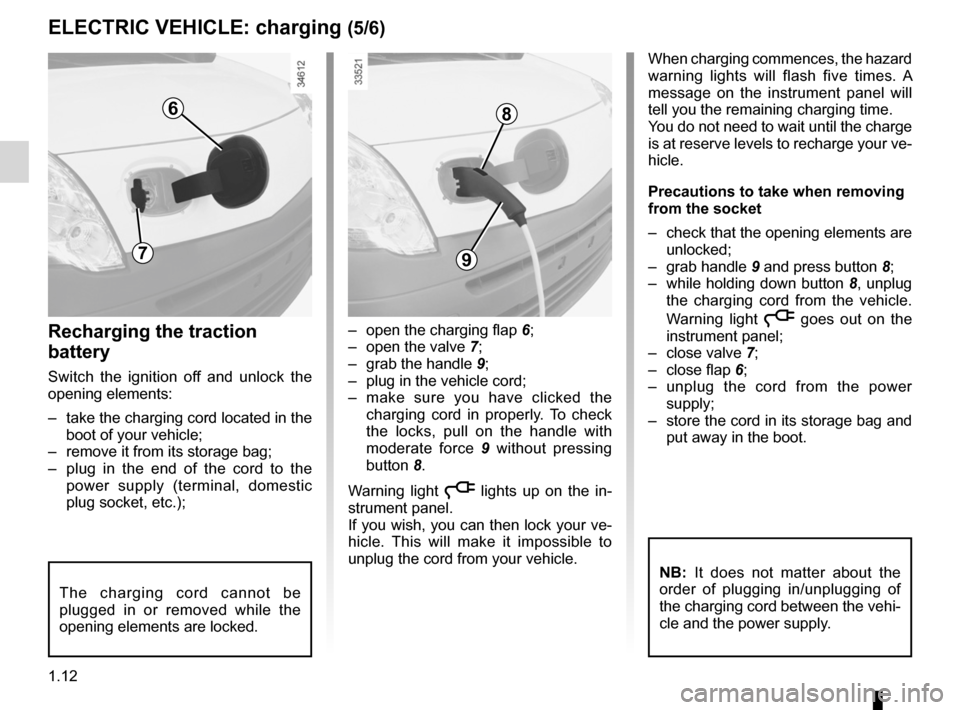
1.12
ENG_UD28552_4
Véhicule électrique : charge (X61 - X61 électrique - Renault)\
ENG_NU_911-4_F61e_Renault_1
Jaune NoirNoir texte
– open the charging flap 6;
– open the valve 7;
– grab the handle 9;
– plug in the vehicle cord;
– make sure you have clicked the
charging cord in properly. To check
the locks, pull on the handle with
moderate force 9 without pressing
button 8.
Warning light
ṋ lights up on the in -
strument panel.
If you wish, you can then lock your ve-
hicle. This will make it impossible to
unplug the cord from your vehicle.
recharging the traction
battery
Switch the ignition off and unlock the
opening elements:
– take the charging cord located in the
boot of your vehicle;
– remove it from its storage bag;
– plug in the end of the cord to the
power supply (terminal, domestic
plug socket, etc.);
electric vehicle: charging (5/6)
When charging commences, the hazard
warning lights will flash five times. A
message on the instrument panel will
tell you the remaining charging time.
You do not need to wait until the charge
is at reserve levels to recharge your ve-
hicle.
Precautions to take when removing
from the socket
– check that the opening elements are
unlocked;
– grab handle 9 and press button 8;
– while holding down button 8, unplug
the charging cord from the vehicle.
Warning light
ṋ goes out on the
instrument panel;
– close valve 7;
– close flap 6;
– unplug the cord from the power
supply;
– store the cord in its storage bag and
put away in the boot.
86
7
The charging cord cannot be
plugged in or removed while the
opening elements are locked.
9
NB: It does not matter about the
order of plugging in/unplugging of
the charging cord between the vehi-
cle and the power supply.
Page 18 of 213

JauneNoirNoir texte
1.13
ENG_UD28552_4
Véhicule électrique : charge (X61 - X61 électrique - Renault)\
ENG_NU_911-4_F61e_Renault_1
electric vehicle: charging (6/6)
Operation notice regarding the
occasional charging cord socket 4
4
10
11
12
Warning lights
reading
READY 10
Green CHARGE 11
Orange FAULT
12
Red
Switched on 0.5 seconds Switched on
0.5 seconds Switched on
0.5 seconds When switching on, the warning
lights go on for half a second to
check that they are operating cor
-
rectly.
Switched on Switched offSwitched offThe charging cord is plugged in to
the domestic plug socket and the
traction battery has finished charg -
ing.
Switched on Switched onSwitched offThe traction battery is charging.
Switched on Switched offSwitched on
or flashing Operating fault.
Unplug the cord
and contact an authorised dealer.
Switched off Switched offSwitched offNo electrical power has been de -
tected at the domestic power socket.
Check your electrical installation
(circuit breaker, etc.) and start again.
If the problem persists, unplug the
cord and contact an authorised
dealer.
Page 19 of 213
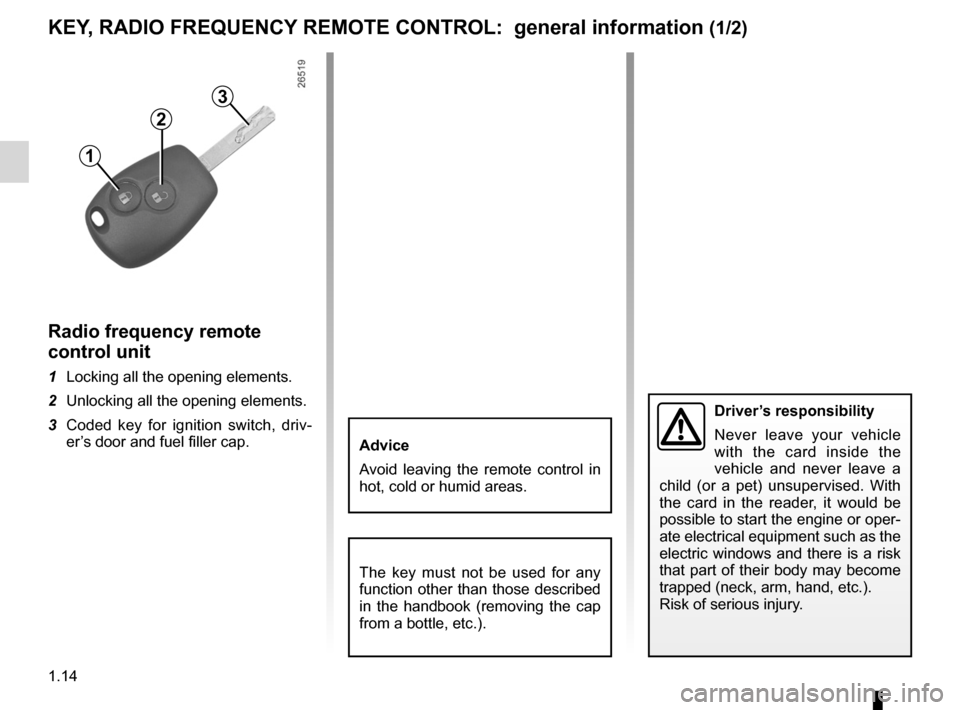
child safety............................................................. (current page)
remote control electric door locking ....................... (current page)
radio frequency remote control/key use ................................................................... (current page)
1.14
ENG_UD17515_4
Télécommandes à radiofréquence : généralités (X61 \
- F61 - K61 - Renault)
ENG_NU_911-4_F61e_Renault_1
Jaune NoirNoir texte
Key, radio frequency remote control: general information, use
KeY, rADiO FreQUeNcY remOte cONtrOl: general information (1/2)
radio frequency remote
control unit
1 Locking all the opening elements.
2 Unlocking all the opening elements.
3 Coded key for ignition switch, driv -
er’s door and fuel filler cap.
1
2
3
The key must not be used for any
function other than those described
in the handbook (removing the cap
from a bottle, etc.).
Advice
Avoid leaving the remote control in
hot, cold or humid areas.
Driver’s responsibility
Never leave your vehicle
with the card inside the
vehicle and never leave a
child (or a pet) unsupervised. With
the card in the reader, it would be
possible to start the engine or oper-
ate electrical equipment such as the
electric windows and there is a risk
that part of their body may become
trapped (neck, arm, hand, etc.).
Risk of serious injury.
Page 20 of 213
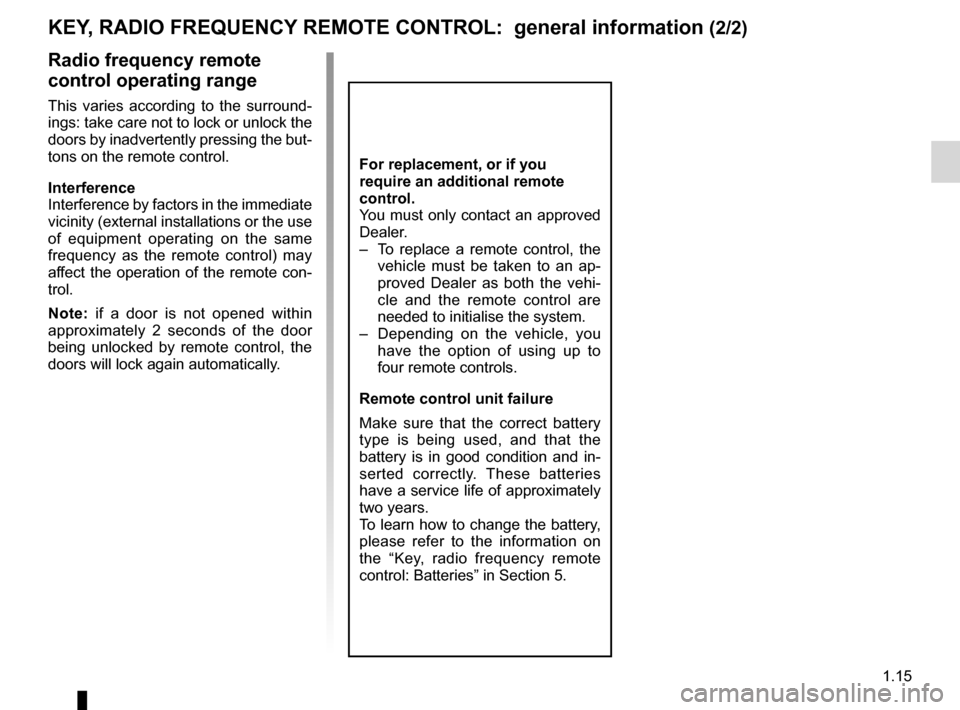
JauneNoirNoir texte
1.15
ENG_UD17515_4
Télécommandes à radiofréquence : généralités (X61 \
- F61 - K61 - Renault)
ENG_NU_911-4_F61e_Renault_1
radio frequency remote
control operating range
This varies according to the surround -
ings: take care not to lock or unlock the
doors by inadvertently pressing the but-
tons on the remote control.
interference
Interference by factors in the immediate
vicinity (external installations or the use
of equipment operating on the same
frequency as the remote control) may
affect the operation of the remote con-
trol.
Note: if a door is not opened within
approximately 2 seconds of the door
being unlocked by remote control, the
doors will lock again automatically.
KeY , rADiO FreQUeNcY remOte cONtrOl: general information (2/2)
For replacement, or if you
require an additional remote
control.
You must only contact an approved
Dealer.
– To replace a remote control, the
vehicle must be taken to an ap -
proved Dealer as both the vehi -
cle and the remote control are
needed to initialise the system.
– Depending on the vehicle, you
have the option of using up to
four remote controls.
remote control unit failure
Make sure that the correct battery
type is being used, and that the
battery is in good condition and in -
serted correctly. These batteries
have a service life of approximately
two years.
To learn how to change the battery,
please refer to the information on
the “Key, radio frequency remote
control: Batteries” in Section 5.